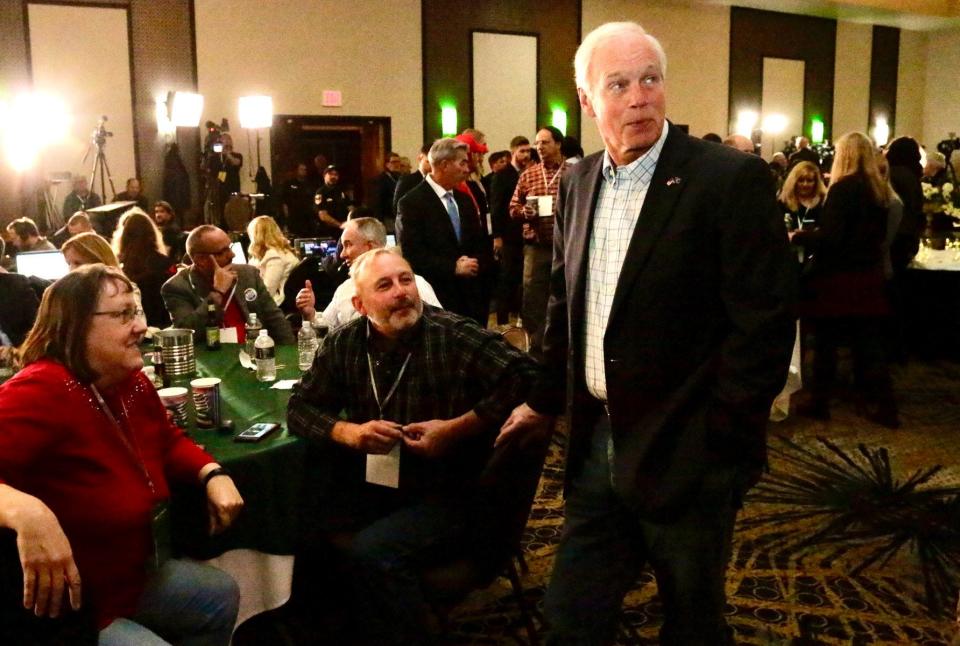Is Republican domination in rural Wisconsin enough to hold off once-red suburbs becoming significantly more Democratic?
It has been eight years since Republican Scott Walker won his last big victory for governor, and the coalition that elected him in Wisconsin three times is showing major leaks.
No community illustrates this better than Walker’s onetime home, the populous Milwaukee suburb of Wauwatosa.
Walker won Wauwatosa by 5 percentage points in 2014.
Then he lost it by 16 in 2018.
And in last month’s race for governor, Republican Tim Michels lost it by 40.

Wauwatosa moved farther in a Democratic direction this fall than any community in Wisconsin of more than 200 people.
And ‘Tosa is not alone.
There have been huge voting shifts away from Republican Party in the Milwaukee suburbs
The suburban half of Walker’s once potent rural-suburban coalition has steadily frayed in the last four election cycles (2016, 2018, 2020 and 2022) — especially in the state’s most populous metro area, Milwaukee.
Nearly 50 Milwaukee-area suburbs have seen a voting shift of more than 20 points since Walker’s 2014 victory, and some have seen shifts of 30 points or more. These shifts have all been away from the GOP.
The steep GOP decline across the suburbs of both Milwaukee and Madison really jumps off the page when you start to examine the vote for governor and U.S. Senate this year at the local level.
To do that analysis, I used an election database compiled by John Johnson, research fellow at the Lubar Center for Public Policy Research and Civic Education at Marquette Law School. The database showed how each one of Wisconsin’s more than 1,800 cities, towns and villages voted in recent election cycles.
Compared to the county-by-county results, the municipal voting patterns give us a sharper picture of where the state’s biggest political shifts — in both directions — are occurring, and what that means for future statewide elections.
And both kinds of shifts are clearly happening. For four elections in a row, not always at the same speed or on the same scale, the high-education suburbs of Milwaukee and Madison have been getting bluer while rural counties and small towns around the state have been getting redder.
Here is a list of places that saw the sharpest swings toward Democrats between the 2018 election for governor, which Democrat Tony Evers won by 1.1 points, and the 2022 election, which Evers won by 3.4 points. (I am excluding from this list communities that produced fewer than 200 votes):
1. Wauwatosa: a 24-point swing (from plus 16.2 Democratic to plus 40.3 Democratic).
2. River Hills: a 24-point swing (from plus 9.4 Republican to plus 14.6 Democratic).
3. Whitefish Bay: a 23-point swing (from plus 20.2 Democratic to plus 43.6 Democratic).
4. Wind Point: a 23-point swing (from plus 11.8 Republican to plus 11 Democratic).
5. Mequon: a 22-point swing (from plus 22.3 Republican to plus 0.8 Republican).
6. Bayside: a 21-point swing (from plus 26.5 Democratic to plus 47.8 Democratic).
7. Elm Grove: a 21-point swing (from plus 25.9 Republican to plus 4.8 Republican).
8. Fox Point: a 21-point swing (from plus 20.4 Democratic to plus 41.3 Democratic).
9. Brookfield: a 20-point swing (from plus 27.8 Republican to plus 7.9 Republican).
10. Menomonee Falls: a 19-point swing (from plus 27.8 Republican to plus 8.5 Republican).
These 10 communities are all relatively high-education, high-income suburbs in the southeastern counties of Milwaukee, Ozaukee, Waukesha and Racine. A little farther down the same list you would find many more places in metropolitan Milwaukee (like Cedarburg, Germantown and Delafield) and numerous Madison suburbs (like Middleton, Fitchburg and Verona).

If the Democratic collapse in rural western and northern Wisconsin was the most dramatic feature of the state’s 2016 election map, then the unchecked Republican decline in suburban southern Wisconsin is the most arresting feature of the 2022 map.
It is all the more striking when you consider that Republicans had reason to believe they might steady their suburban ship this year, with Donald Trump not on the ballot, with a Democrat in the White House who has poor job ratings, with crime and inflation playing prominent roles in the campaign.
But that didn’t happen. The Supreme Court’s abortion decision overturning Roe v. Wade is certainly one possible explanation for this, but the trend goes back to 2016, when the state’s most populous suburbs lurched away from the GOP. And it has persisted in the Trump era across different election cycles, contests for different statewide offices, and battles between different candidates.
While in the long run, these suburban shifts undoubtedly reflect changes in the composition of the metropolitan suburbs (the kinds of people moving in and out), the partisan changes are so dramatic from one election to another that population trends alone can’t account for them. Voter preferences are also shifting (just as they have moved in the opposite direction in so many rural communities).

Recent election cycles show that former Waukesha County Republican strongholds are turning purple
Some of these fast-changing communities are blue places that are getting bluer, while others are red places that are becoming a lot more purple.
Waukesha County, which has long been the most important Republican County in Wisconsin, has 24 communities that saw double-digit shifts toward the Democratic Party between 2018 and 2022. It has 21 communities that have shifted at least 20 points since 2014, based on how they have voted for governor.
Walker won Elm Grove by 43 points in 2014. But his margin decreased to 26 points in 2018, and Michels won it by just 5 in 2022.
Walker won Brookfield by 46 points in 2014. That declined to 28 points in 2018. Then Michels won it by just 8 in 2022.
This pattern is not confined to elections for governor.
Republican Sen. Ron Johnson, who was narrowly re-elected last month, performed much worse in the red and blue suburbs of Milwaukee than he did six years earlier in 2016. Johnson lost Wauwatosa by 7 points in 2016, then by 37 in 2022. He won Mequon in Ozaukee County by 28 points in 2016 but only 6 in 2022. His victory margin in Menomonee Falls in Waukesha County declined from 32 points six years ago to 14 points last month. His overall margin in suburban Waukesha County shrank from just under 38 points to just over 25.
There is another side to this equation, of course, which helps explain why Johnson was able to hang on to his seat this year.

Republicans have steadily had a red wave in rural Wisconsin
Republicans are doing better than ever in rural Wisconsin.
The GOP surge (and Democratic collapse) in rural Wisconsin happened first at the gubernatorial level, with Walker’s victories in 2010, 2012 and 2014. Then it happened at the presidential level with the two Trump elections of 2016 and 2020.
One way to measure this is to use Wisconsin’s more than 1,200 towns as a proxy for the rural vote. Towns account for about two-thirds of the state’s communities (the rest are cities and villages), but only about 30% of the statewide vote, because these communities are overwhelmingly small.
In the 2006 contest for governor, won by Democrat Jim Doyle, Republicans carried Wisconsin’s towns by a combined margin of 5.5 points. Then came the rural red wave. Walker carried Wisconsin’s towns by 23 points in 2010 and by 25 points in 2014.
In the 2012 race for president, won by Democrat Barack Obama, Republicans carried the towns by 12 points. But Trump carried them by 25 in both 2016 and 2020.
This year, Michels did almost as well as Trump in the towns (winning them by 24 points). In the Senate race, Johnson won them by more than Trump or Walker ever did – 29 points. It was also an improvement on Johnson’s own performance in 2016, when he won the towns by 25 points.

Democrats lost ground in other traditional 'blue' cities in Wisconsin outside of Milwaukee and Madison but it didn't cost them
Small towns were not the only places Republicans saw gains and Democrats saw losses in 2022.
In voting for governor, Democratic margins shrunk in some blue cities such as Kenosha (from 23 to 17 points) and Beloit (from 30 to 24 points). Democrats won the city of Milwaukee by a bigger point margin than 2018 (62.9 points compared to 58.4), but their winning vote margin was about 14,000 votes smaller because of lower turnout.
Overall, though, Democrats gained ground this year in both cities (which account from almost half the statewide vote) and villages (which account for almost a fifth).
That reflects two kinds of gains. Democrats increased their margins in many more urban places such as Madison, Eau Claire, Appleton and Green Bay. But their more dramatic gains came among suburban voters, who overwhelmingly live in communities that are organized as either cities (such as Wauwatosa, Brookfield, Sun Prairie and Mequon) or villages (such as Menomonee Falls, Whitefish Bay and Waunakee).
These examples all come from the Milwaukee and Madison metro areas.
But many suburban communities around Green Bay and Appleton also got bluer in this election, though the trend was not as dramatic as it was in the Milwaukee and Madison areas. Republicans won De Pere by 3 points for governor in 2018 but lost it by 6 in 2022; Democrats won the village of Allouez by 1 point in 2018 and won it by 14 in 2022.
Another way to sum up these voting trends in Wisconsin is that a lot of small communities are getting redder, but bigger places are getting bluer, reflecting other national divides: between college and non-college voters, religious and secular voters, etc.
And that “tradeoff” was good for Democrats this year.
To illustrate that point: between 2018 and 2022, the GOP margin for governor improved by about 11,000 votes in the combined vote of Wisconsin’s more than 1,200 towns.
But the GOP margin for governor declined by almost 12,000 votes in just three Waukesha County suburbs: Brookfield, Menomonee Falls and New Berlin.
Comparing the 2022 race for governor with the 2018 race for governor, Republicans did better in almost two-thirds of Wisconsin’s localities. But those places on average cast about 620 votes.
The places that got more Democratic on average cast almost 3,000 votes.
And of the 30 communities in Wisconsin that cast the most ballots this year (a list that runs from Milwaukee through Manitowoc), only one moved in a Republican direction between the 2018 and 2022 races for governor: Kenosha.
Will Republicans' gains in smaller Wisconsin communities be enough for declines elsewhere?
These broad trends don’t make Democratic victories in statewide Wisconsin elections inevitable. In 2016, Trump became the first Republican to win this state for president since Ronald Reagan because his rural gains outweighed his suburban losses. He almost won again in 2020 with the same formula. And Johnson won his Senate race this fall despite losing ground in many populous suburbs.
But the big question for Republicans after this election is whether their rural inroads can keep pace with their suburban erosion, especially when the suburbs are growing more in population.
The pace of the party’s rural gains has slowed after the massive inroads of 2010 through 2016. Meanwhile, the GOP’s losses in metro Milwaukee and Madison continued to mount this year, as the two parties’ regional coalitions continued to shift and communities that were once vital electoral building blocks for one party have instead become essential to the other party.
Wauwatosa is the prime example of how a community can flip over time
Which brings us back to Wauwatosa.
Two decades ago, Republican George W. Bush won Wauwatosa by 4,522 votes. Only five communities in Wisconsin gave Bush a bigger vote margin.
This fall, Evers, a Democrat, won Wauwatosa by 10,710 votes.
Only two communities in Wisconsin gave Evers a bigger vote margin.
That’s right: the third biggest contributor to the Democrats’ victory for governor after the big blue bastions of Milwaukee and Madison was Wauwatosa, not a traditional blue city like Racine or Kenosha or Janesville or La Crosse.
In 22 years, this Milwaukee suburb has gone from being one of the single most important sources of Republican votes in Wisconsin to being one of the single most important sources of Democratic votes.
Wisconsin remains a battleground, as it was two decades ago. But for both parties, the path to victory is changing before our eyes.
Editor's note: This story has been updated to correct the margin of the Democratic swing in Whitefish Bay.

Craig Gilbert provides Wisconsin political analysis as a fellow with Marquette University Law School's Lubar Center for Public Policy Research and Civic Education. Prior to the fellowship, Gilbert reported on politics for 35 years at the Journal Sentinel, the last 25 in its Washington Bureau. His column continues that independent reporting tradition and goes through the established Journal Sentinel editing process.
Follow him on Twitter: @Wisvoter.
This article originally appeared on Milwaukee Journal Sentinel: Wisconsin remains politically purple. But the way to win is changing.
